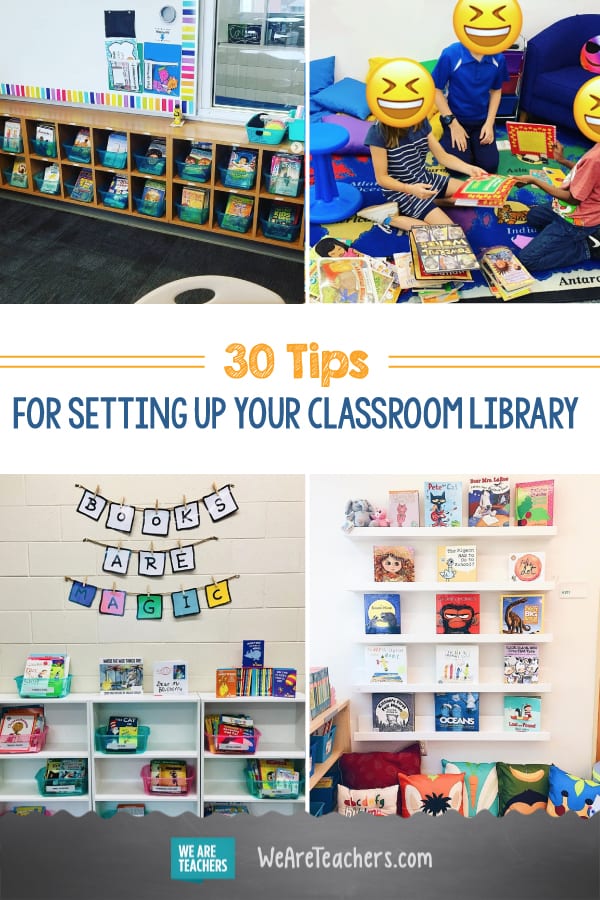We all know how important it is for kids to be able to access a steady supply of appealing and inspiring books for in-class reading. So, you keep up with the latest, best books for your grade level and hoard book reward program points and scour sales to build your stacks. But, the question remains: How do you set up your classroom library so it’s functional, supports instruction, and above all, makes kids clamor to get in there and spend time reading and talking about books? Well, there’s no one right answer, but don’t worry—we’ve pulled together this list of awesome classroom library ideas for you.
1. Find your ideal flow.

Envision how kids will move through your library space to choose books. Are there any bottlenecks? Rearrange as needed. Bookshelves like these that can be accessed from both sides might help!
Source: @my_teaching_adventures
2. Display featured titles prominently.
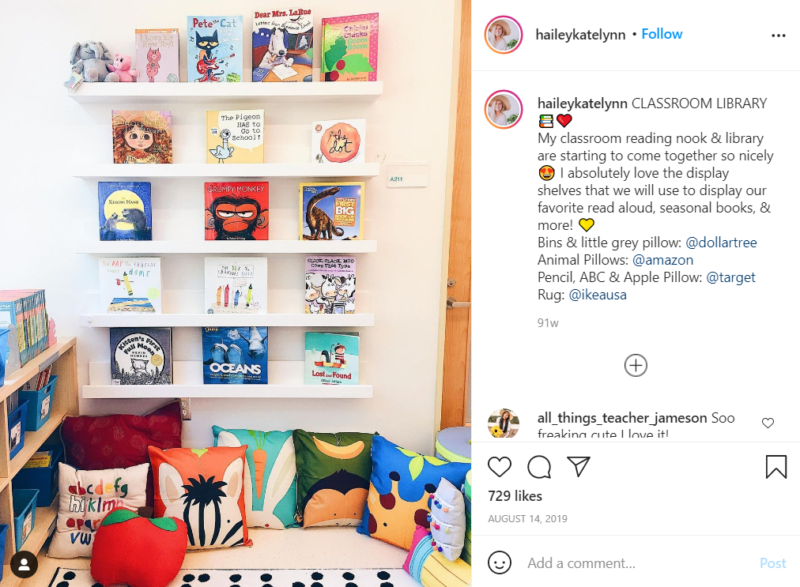
Kids gravitate to what catches their eye. Make sure those things are books! We love the clean, uncluttered feel of this display wall for recent read alouds and seasonal favorites.
Source: @haileykatelynn
3. Make the distinction between fiction and nonfiction easy to see.
This is perhaps the most basic distinction students must learn to make. Unify collections divided by topic or series with matching bins or by labeling areas of the library. Make sure you stock a balance of both, too.
[contextly_auto_sidebar]
4. Categorize books to support student choice.

Source: I Want to Be a Superteacher
Help kids figure out if they’re mystery lovers or history buffs. I Want to Be a Superteacher breaks down the process of organizing by genre, right down to suggestions for straightforward graphics to use on bin labels. You can divide larger genres by series, author, or topic.
5. If you must level, go for a hybrid approach.
Book levels have been the subject of plenty of debate, and there are convincing reasons why leveling isn’t optimal for classroom libraries. If you feel strongly about leveling some books, consider limiting it to books used for a particular related purpose, like fluency practice or take-home books.
6. Use sticker cues to help books get back to their bins.

If you store books in categorized bins, younger kids can match a picture sticker to the bin label. (How adorable are these pigeon ones?)
Source: @kindergartenisgrrreat
7. Or, use a numbering system.
Fifth grade teacher and classroom library guru Colby Sharp explains his system of numbering each book bin and attaching a corresponding number to each book. (Plus, we love his rationale for keeping it simple with duct tape bin labels instead of fancier ones.)
8. Or, color-code book spines.
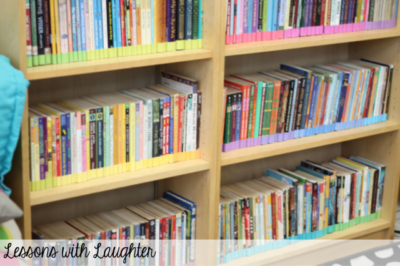
SOURCE: Lessons with Laughter
In some cases, it’s more practical to store chapter books spine out. Keep them organized for easy choosing with color-coded spine labels. Lessons with Laughter makes it look so pretty!
9. Or, label shelves or sections.
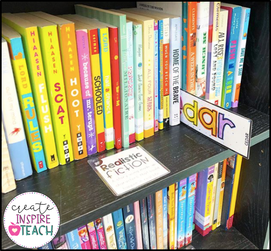
SOURCE: Create Inspire Teach
If you prefer to “ditch the bins,” add descriptive labels for each book category straight on your shelves.
10. Designate a spot for books you’ve read aloud so kids (and you) can revisit them.
You chose your read alouds because they’re the best, so of course kids will want to reread them. Tammy Mulligan and Clare Landrigan suggest storing read alouds you’ve already read in tubs labeled by month to make them easy to find.
11. Define areas to support different parts of your curriculum.
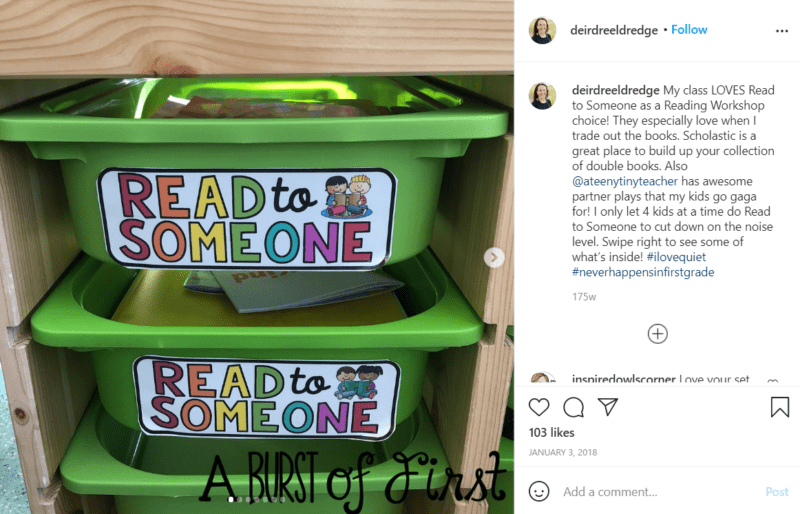
Sometimes you want kids to head straight to a certain selection of books for a certain task. Make it easy by creating sections of your library for books for different purposes, like partner reading, mentor texts, or content-area research books.
Source: @deirdreeldredge
12. Start with some space on the shelves.
Don’t pull out all your books right when school starts! Getting out books in phases builds excitement, gives you time to slowly teach kids about different types of books, and lets your library grow and evolve with your students’ interests, needs, and curriculum.
13. Cull your collection down to the best titles.
It can induce teacher panic to think about getting rid of books, but you should feel great about every single book your kids grab from your library. Sara at The Colorful Apple breaks it down for you with the acronym MUSTIE, coined by the Texas State Library and Archives Commission: ditch books that are Misleading, Ugly, Superseded, Trivial, Irrelevant, or easily found Elsewhere.
14. Check for gaps in representation and aim to fill them over time.
The idea of updating your entire library to be more diverse can feel like an enormous task. Jill Eisenberg of Lee & Low Books provides a classroom library questionnaire to get you started and reassures, “If you add a few critical titles to your collection this year, you are on your way.”
15. Invest in a personalized book stamp.
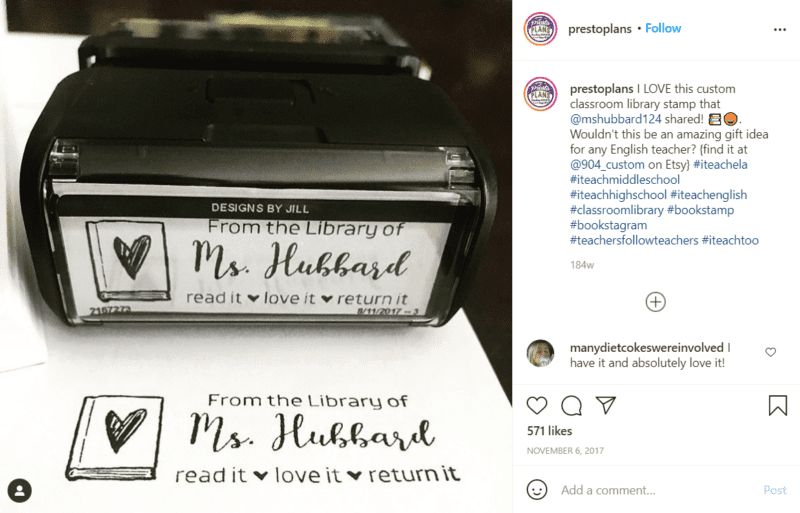
Yes, a Sharpie or printed mailing label can also help make sure your precious books make their way home to your classroom library, but you can’t deny that these stamps are adorable and fun.
Source: @prestoplans
16. Involve students in sorting books.

Create ownership by having students help sort books at the start of the year and as you add new titles to your library.
Source: @growandglow.teaching
17. Better yet, have kids make labels too.
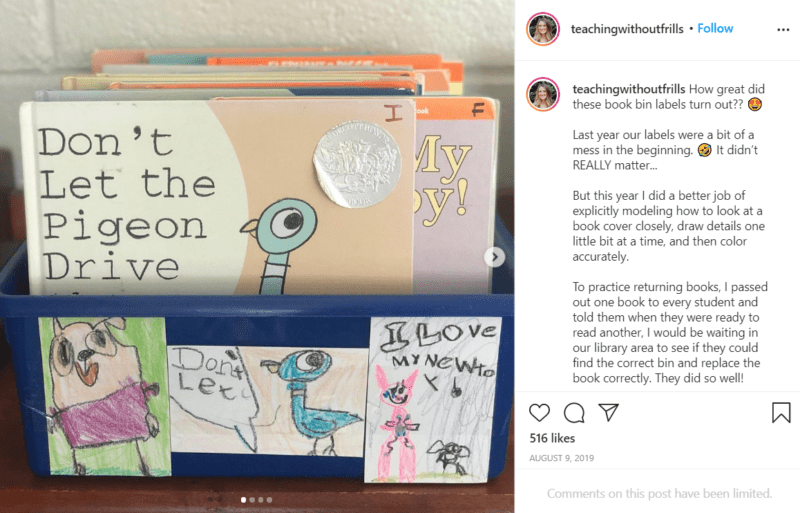
What an amazing opportunity to create ownership and get kids really looking at the books in each bin.
Source: @teachingwithoutfrills
18. Teach kids what your labels mean.
Use genre descriptions that double as guidance on choosing books.
19. Rotate your book bins all year long to keep your library fresh.
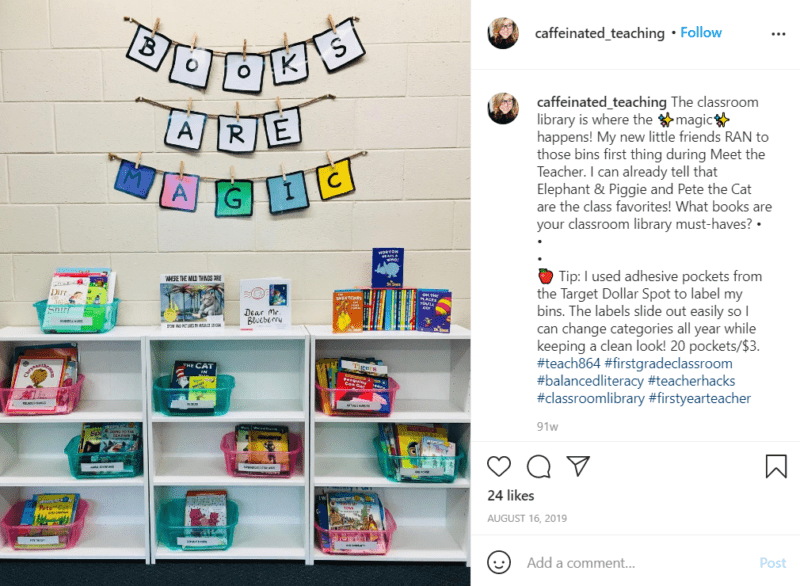
Genius teacher hack: Affix clear pockets to your bins for labels for easy swapping.
Source: @caffeinated_teaching
20. Host a grand opening (or reopening).
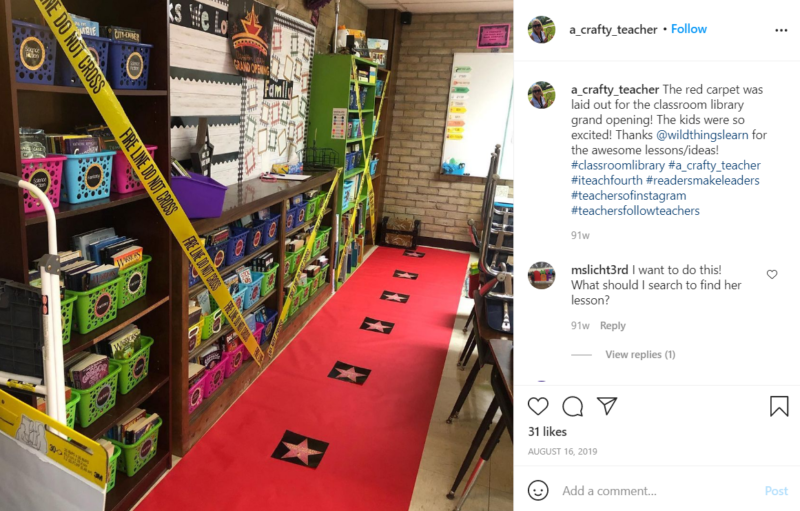
Generate a buzz about this important classroom spot.
Source: @a_crafty_teacher
20. Show your students that your library is made for them by featuring their faves.
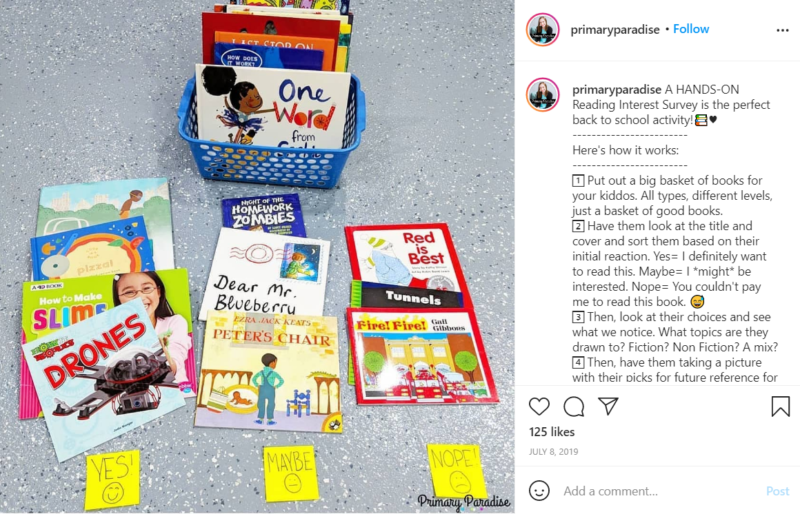
At the start of the year, give a reading interest survey—we love this hands-on version. Use the information you gather about kids’ interests to place high-appeal books, topics, series, and authors front and center to draw kids in.
Source: @primaryparadise
21. Send kids on a classroom library scavenger hunt.
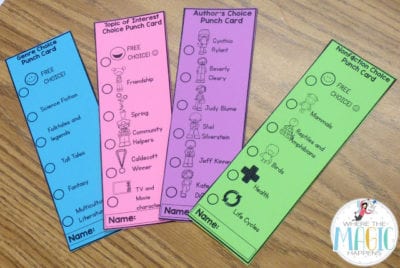
SOURCE: Where the Magic Happens
Familiarize kids with what’s available and build excitement. This punch-card version from Where the Magic Happens looks so fun!
22. Curate unique text collections.
It’s All About the Books: Creating Classroom Libraries and Bookrooms that Inspire Readers by Tammy Mulligan and Claire Landrigan has a mega-list of interesting book categories to entice readers and support your curriculum, like Tear Jerkers or You Won’t Believe It. You can even task kids with gathering collections to display. (P.S. If you’re looking to read more about classroom libraries, this book is a go-to professional resource. You can plow through it in a few hours, and it’s filled with advice, images, lists, real-life anecdotes, and more.)
23. Display trending recommendations.
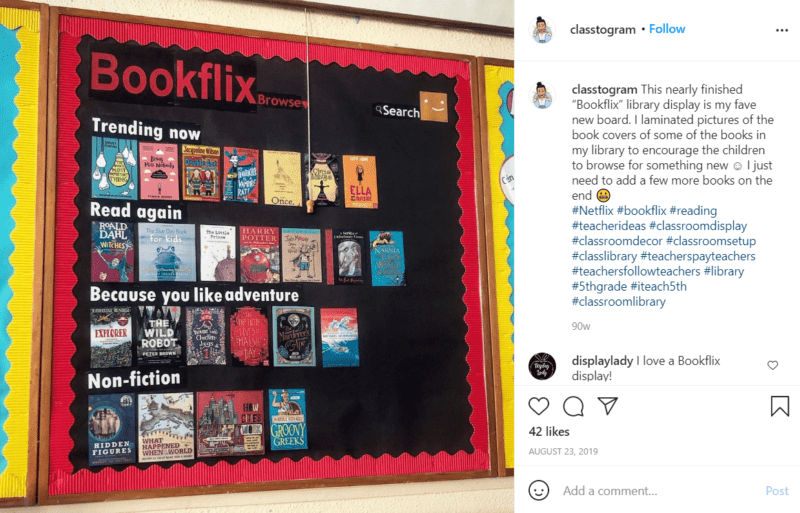
Help kids easily move from one great book to the next by having plenty of suggestions at the ready. Check out the #Bookflix boards that are popping up all over Insta!
Source: @classtogram
24. Highlight “staff” picks.
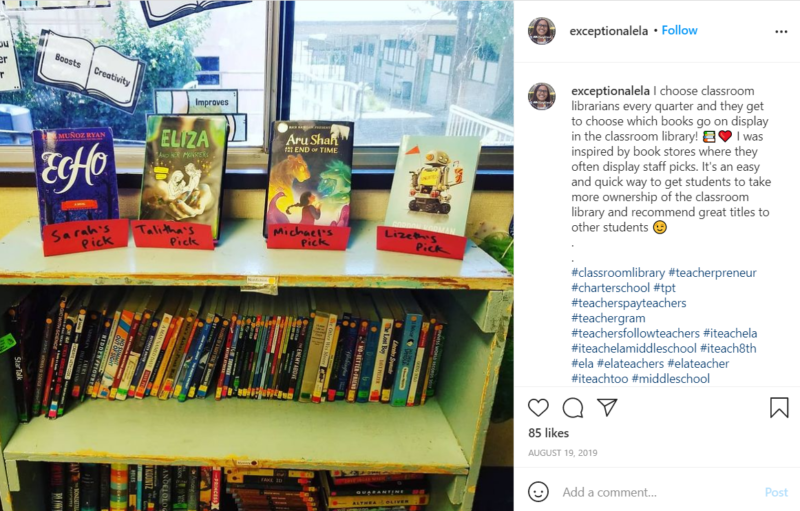
Recreate the irresistible draw of recommendation shelves in local bookstores or the library with rotating student recommendations. You could invite others—like administrators, other classes, or the custodian—to share their recos, too.
Source: @exceptionalela
25. Add audiobook options.
Audiobooks provide so many complementary benefits to print books, like boosting book access for kids of different reading levels or language backgrounds, expanding your book choices, and motivating readers. Set up a classroom Audible account or explore the many free options available.
26. Create a system for intercepting misplaced and damaged books.

Hopefully students will return books to your library correctly themselves, but give them a dedicated place to leave them if they aren’t sure, or if the book is in need of repair. We love how this version combines a return bin and book hospital into a portable package.
Source: @teachernook
27. Hire a (student) librarian.
Ideally, all students take ownership of your classroom library space, but clearly defining a caretaking role can help keep things in tip-top shop, organized condition. Task the librarian with facing books in the right direction and returning books to the correct bins or shelves at the end of each day.
28. Use a classroom library app.

Make your classroom library feel as authentic as a “real” library for kids and save tons of your time and resources keeping track of your books with a classroom library app.
Source: @smilingwithscience
29. Keep a wish list.
Once you’ve inventoried all your books electronically or by hand, use the gaps you spot to create a wish list. Keep it handy for when you’re able to add books to your collection so you know whether you need #2 or #7 in a popular series or more nonfiction titles about sharks or samurai. Write down student requests, too.
30. Be patient.
If you’re a new teacher with a small library, or transitioning from a different approach, keep in mind that building the best classroom library takes both time and trial and error. Building up a thoughtfully curated book collection takes years, and you’ll likely change up your setup a bit with each new class. Stick with it; it’s a worthy cause!
We’d love to hear—what are your favorite classroom library ideas and tips? Come and share in our WeAreTeachers HELPLINE group on Facebook.
Plus, why we need to stop letting reading levels define our students.
